- Quick Read
- Deep Read ( 7 Min. )

Why is Christian Science in our name?
Our name is about honesty. The Monitor is owned by The Christian Science Church, and we’ve always been transparent about that.
The Church publishes the Monitor because it sees good journalism as vital to progress in the world. Since 1908, we’ve aimed “to injure no man, but to bless all mankind,” as our founder, Mary Baker Eddy, put it.
Here, you’ll find award-winning journalism not driven by commercial influences – a news organization that takes seriously its mission to uplift the world by seeking solutions and finding reasons for credible hope.
Explore values journalism About usIn Today’s Issue
Monitor Daily Podcast
- Follow us:
- Apple Podcasts
- Spotify
- RSS Feed
- Download
TODAY’S INTRO
Job swapping: The ultimate lesson in empathy
Watching luggage pile up in airports and delayed passengers pack terminals for months, Australia’s largest airline, Qantas, has come up with a solution to the travel disruptions. It has asked executives to leave office suites to help haul luggage.
According to a memo written by CEO Colin Hughes, the airline needs 100 volunteers to work shifts of up to three months at the main airports in Sydney and Melbourne, to address a labor shortage that contributed to 8.1% of domestic flights being canceled in June.
Going from “pushing paper” to pushing suitcases, which could weigh up to 70 pounds each, will hopefully ease the airline’s temporary logistical woes. But the unintended consequence might be more long-lasting: putting management in the shoes of workers.
I have worked at the Monitor for 20 years, mostly as an international correspondent in Mexico City, Paris, and now Toronto. The relationship with “Boston,” as we writers here call the editors, is mostly harmonious. But frustrations sometimes mount. It can sound something like this: “Editor, I stayed up all night to finish this article that you said you needed right away, and two days later no one has even read it!”
Over the holidays this past year, I was asked to fill in on the international editing desk to manage some of our own staffing shortages. On my first day, I didn’t have time for lunch. I was quickly humbled by how many moving parts there are and how much goes into the production of our paper beyond my individual labor. I suddenly understood why, when I file a story, it’s not always read right away or has to wait to be published. Marveling at it still as I take on more editing duties, I have mentioned a “job swap” to our managing editor, as an exercise in understanding others and our collective daily efforts.
My experience at the Monitor applies to the most polarized issues of our day. Support for immigration is always highest among those who have immigrants as neighbors. Even the hardest views against abortion can be malleable when a family member or close friend finds herself in need.
In this case, Qantas surely has its eye on the company’s bottom line. But the airline may just be providing staff the ultimate training in empathy.
Share this article
Link copied.

Help fund Monitor journalism for $11/ month
Already a subscriber? Login

Monitor journalism changes lives because we open that too-small box that most people think they live in. We believe news can and should expand a sense of identity and possibility beyond narrow conventional expectations.
Our work isn't possible without your support.
What Mar-a-Lago search portends for US and a president
The FBI took an unprecedented step of searching a former president’s residence. To Trump supporters, it smacked of political retribution. To opponents, the search – which a judge signed off on – shows that no one is above the law.

-
Henry Gass Staff writer
-
Patrik Jonsson Staff writer
-
Harry Bruinius Staff writer
The FBI search of former President Donald Trump’s Mar-a-Lago retreat represents one of the most politically sensitive – and possibly explosive – law enforcement actions ever taken by the United States Department of Justice.
To Mr. Trump’s opponents, the sweep indicates that the Justice Department seems determined to hold even former U.S. chief executives subject to the rule of law. Trump supporters expressed outrage about what they said was unjust political persecution of President Joe Biden’s possible 2024 opponent.
Revelations as to what the search was after, what it found, and the context of the FBI’s investigation could affect these relative positions. But the moment agents passed through the gates, the once unthinkable prospect of the prosecution of someone who sat in the Oval Office seemed, if not probable, more possible. Given the tensions of today’s polarized nation, the consequences of such a move remain unpredictable.
Richard Davis, who served as an assistant U.S. attorney during Watergate, remembers when the nation last faced a similar predicament.
Today’s situation is more dangerous than Watergate, he says. There was partisanship then, too. But the Jan. 6 insurrection has shown that heated words can lead to action.
“We are at a risk of crossing a divide,” says Mr. Davis.
What Mar-a-Lago search portends for US and a president

The FBI search of former President Donald Trump’s cherished Mar-a-Lago retreat represents one of the most politically sensitive – and possibly explosive – law enforcement actions ever taken by the United States Department of Justice.
To Mr. Trump’s opponents the sweep indicates that the Justice Department seems determined to hold even former U.S. chief executives subject to the rule of law. Attorney General Merrick Garland himself almost certainly had to approve the Mar-a-Lago search warrant application, say legal experts.
Trump supporters erupted following the search, expressing outrage about what they said was unjust political persecution of President Joe Biden’s possible 2024 opponent.
Revelations as to what the search was after, what it found, and the context of the FBI’s investigation could affect these relative positions. News reports indicated agents wanted documents Mr. Trump had brought to Mar-a-Lago from the White House.
But the moment agents passed through the Florida retreat’s gates, the once unthinkable prospect of the prosecution of someone who sat in the Oval Office seemed, if not probable, more possible. Given the tensions of today’s politically polarized nation, the consequences of such a move remain unpredictable.
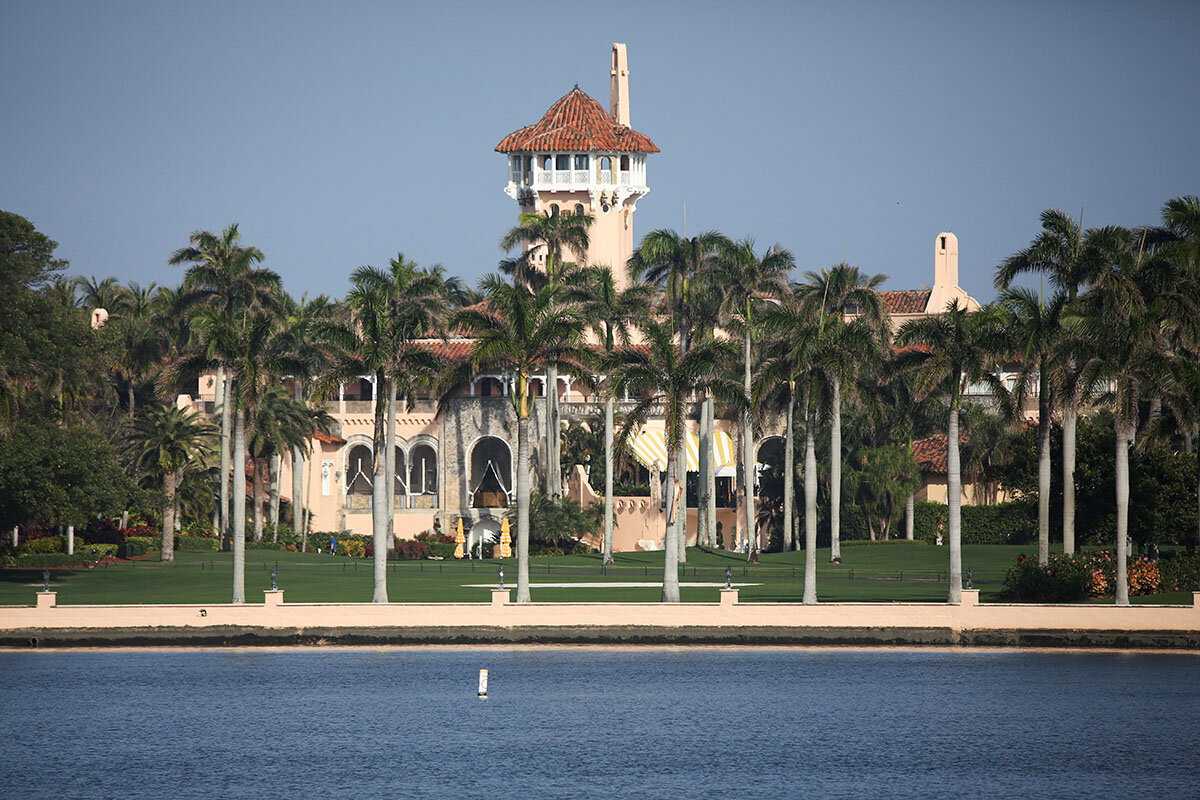
Richard Davis, who served as an assistant U.S. attorney on the Watergate prosecution force, remembers when the nation last faced a similar predicament.
Today’s situation is more dangerous than Watergate, he says. There was partisanship then, too. But the Jan. 6 insurrection has shown that heated words can lead to action.
“We are at a risk of crossing a divide,” says Mr. Davis, now a New York-based attorney.
Serving a former president
Few specifics around the FBI investigation that led to the Mar-a-Lago search are clear. But law enforcement experts believe it has heightened Mr. Trump’s legal jeopardy.
“The majority of searches of this sort [result] in federal criminal charges,” says Harry Litman, a former U.S. attorney and deputy assistant attorney general.
What we know at this stage is that the Justice Department is investigating possible illegal retention of official documents by Mr. Trump. Almost all presidential and federal records belong to the U.S. government, not the president or officials themselves, and there are several federal laws outlining what records are illegal for officials to take home with them.
To authorize the search last night, the FBI would have had to convince a federal judge that it was likely the former president had committed a crime, and that evidence of that crime would be found at Mar-a-Lago. And of the possible laws the government may be investigating Mr. Trump of breaking, one stands out: 18 U.S. Code §2071, which prohibits the “concealment, removal, or mutilation” of records belonging to the U.S. government.
Official charges are likely still some way off, however, if they come at all, according to Chuck Rosenberg, a former U.S. attorney and senior FBI official.
“This [search] does not mean that he will ultimately be charged with a crime,” he wrote in an email to the Monitor. “If charges will be brought, it is almost certain that prosecutors and agents have more work to do.”
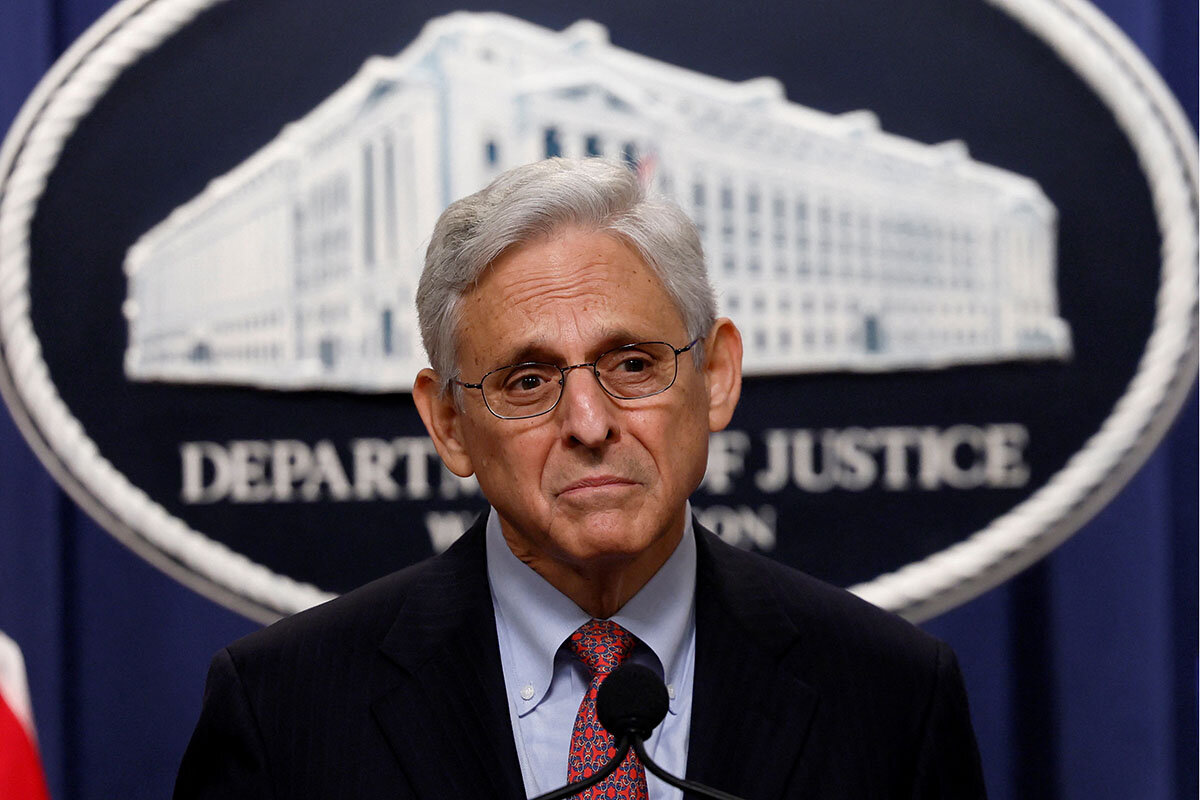
But the timing of the search raises questions. Mr. Trump has said he was cooperating with authorities looking to retrieve government records, raising the possibility that the Justice Department was worried that documents could be destroyed or removed. (The National Archives said in February it was communicating with the DOJ about recovering records from Mr. Trump.)
Executing a search warrant would help prevent such destruction, said Mr. Rosenberg, so that could have been a concern.
But “we do not know that just yet, and we need to be careful about conjecture, here,” he added.
This kind of law enforcement action against a former president is unprecedented, and Justice Department officials would have been aware of that before authorizing the search, according to Mr. Litman, who also teaches constitutional law at the University of California’s San Diego and Los Angeles campuses. They would have been conscious they were serving a warrant on a former president for the first time ever.
“It couldn’t have been less than the No. 2” at the DOJ who approved the search, he adds, “and I think it would have been [Attorney General] Garland.”
Mr. Trump and his allies immediately criticized the search as a politically motivated abuse of power by the Justice Department. But what has happened to Mr. Trump in the past 24 hours is what normally happens to any criminal suspect in such an investigation, experts say.
“A ‘neutral and detached’ judge authorized the warrant once prosecutors met the legal threshold required by the Fourth Amendment,” wrote Mr. Rosenberg.
“That [criticism] was to be expected ... but this is law enforcement, without fear or favor,” says Mr. Litman.
A politicized Justice Department?
News of the FBI raid drew an immediate, fierce response from many Republicans.
Mr. Trump himself issued a statement that began, “These are dark times for our Nation, as my beautiful home ... is currently under siege, raided and occupied by a large group of FBI agents.”
House Minority Leader Kevin McCarthy of California said the Department of Justice “has reached an intolerable state of weaponized politicization” and vowed an investigation of Attorney General Garland and the department if the GOP retakes the House in upcoming midterm elections.
The mere fact that such a search occurred, said many Republicans, was meant to influence the November vote while damaging Mr. Biden’s most likely 2024 rival.
“What is it, 100 dog days from the congressional election?” says Frank Buckley, a former speechwriter for the Trump campaign and a professor at the Antonin Scalia Law School at George Mason University in Arlington, Virginia. “My initial reaction is, we’ve descended from a concrete rule of law to one where justice is influenced by political considerations.”
Professor Buckley volunteered early on to help Mr. Trump win the presidency, and since then he’s been a leading thinker in the transformation of American conservatism, defending the kind of “America First” nationalism that held so much appeal to the movement that swept Mr. Trump into office.
He’s since become a critic of the former president, however, believing Mr. Trump ultimately lacked the character to hold the nation’s highest office – even if his general policy goals overlapped with his own.
Still, the search of Mar-a-Lago seems to him to be part of a larger political calculus.
“If you’re a Democrat, all you’ve got is Trump, Trump, Trump, and they won’t give it up,” says Professor Buckley, who describes the new brand of conservative ideas in his latest book, “Progressive Conservatism: How Republicans Will Become America’s Natural Governing Party.”
“The worst nightmare for Democrats would be [Mr.] Trump saying, I’m not going to run. Well, now he’s much more likely to run, sadly,” he says.
“This is serious stuff”
The FBI investigation into Mr. Trump’s retention of presidential records, including classified material, is just one of a number of law enforcement probes the former president is facing.
In New York, Attorney General Letitia James is conducting a civil inquiry into whether The Trump Organization committed fraud by improperly inflating the value of assets.
In Georgia, Fulton County District Attorney Fani Willis is looking at whether to bring criminal charges in conjunction with the efforts of the former president and his allies to overturn the state’s 2020 election results.
In Washington, the Justice Department is conducting a widespread investigation into the larger effort of Trump allies to keep the former president in office despite his election loss.
There is no indication that Monday’s FBI search was linked to questions about Mr. Trump’s effort to pressure state officials or questions dealing with events leading up to the Jan. 6 insurrection at the Capitol.
So why did the FBI take the big step of initiating a search of Mr. Trump’s residence? It is possible the FBI believes it was misled about what documents were retained at Mar-a-Lago, and obtained a search warrant on those grounds. It is also possible officials were worried that retained documents were being, or about to be, destroyed.
Mr. Trump returned 15 boxes of material in January, but only after delaying for many months, and in the face of threatened further action from the National Archives.
The preservation of presidential archives is not a small thing, says Julian Zelizer, a Princeton University historian and editor of “The Presidency of Donald J. Trump: A First Historical Assessment.”
“The whole commitment to preservation [of presidential records] really solidifies after Watergate, after the tapes and the battle over the tapes,” says Professor Zelizer. “There’s a realization that this material has consequences, and that sometimes presidents and other politicians don’t want to let people see what happened, because it has a big effect.”
Documents help provide accountability, he says. They provide insight into what presidents did, and what officials in their administration were saying and doing.
“This is serious stuff,” says Professor Zelizer.
The larger point is to ensure that no person is above the law, says presidential historian Lindsay Chervinsky, author of “The Cabinet: George Washington and the Creation of an American Institution.”
Mr. Trump has been out of office for more than 18 months and has retained the records all that time, suggesting that the former president has been given a lot of leeway, says Dr. Chervinsky. Justice officials may have decided to force the issue.
Mr. Trump has a solid core of supporters who will back him no matter what, she adds, “so I think that the focus needs to be on doing what is right, even if it is unpopular at the moment – knowing that it would be more damaging to the nation’s future to not do what is right.”

Gun rights vs. music festivals: How do you keep people safe?
Many gun owners feel safer while carrying guns. But the Music Midtown festival canceled instead of letting in firearms. It speaks to shifting views of safety after this summer’s Supreme Court decision.

- Quick Read
- Deep Read ( 5 Min. )
Music Midtown has come to define Atlanta’s ascension as a cultural beacon in the South. The festival has helped Atlanta join the echelon of top music cities, rivaling New York, Los Angeles and, yes, even Nashville a few hours to the north.
But this year, it will not happen. Organizers decided the recent push to further loosen gun laws created too great a risk for a festival that draws 50,000 revelers a day.
Gun rights long have been a matter of balancing a more communal notion of public safety with individuals’ rights to protect themselves. This summer’s Supreme Court decision bolstered the latter. Cities and states are now sorting new political and policy priorities in light of the ruling. The cancellation of the Midtown Music festival points to how communities are recalibrating how they can best feel safe in the new legal environment.
“We’re grappling with the reality of changed laws around guns,” says Doug Shipman, president of Atlanta’s City Council. “So, how do you think about large gatherings? How do you think about keeping people safe?”
Gun rights vs. music festivals: How do you keep people safe?

Micheal Evans remembers the pure funk-fueled mayhem.
It was 2013, and the Red Hot Chili Peppers were rocking Piedmont Park at the Music Midtown festival. The crowds massed in Atlanta’s version of Central Park bounced to the California rock band’s beats. Mr. Evans has one enduring memory: It was so much fun.
This year, however, there will be no Music Midtown festival. It was called off when organizers concluded that the recent push to further loosen gun laws created too great a risk for a festival that draws 50,000 revelers a day.
Mr. Evans can understand both sides as a former police officer who at times carries a concealed weapon. “It is all very disappointing.” Though he adds: “Large crowds, alcohol, excited emotions, and guns aren’t necessarily the best mix.”
Beneath the angst about the festival itself is a deeper question about how America views safety – and how that is shifting. Gun rights long have been a matter of balancing a more communal notion of public safety with individuals’ rights to protect themselves.
This summer’s Supreme Court decision bolstered the individuals, saying the Constitution holds that law-abiding citizens can carry concealed weapons nationwide. Cities and states are now sorting new political and policy priorities in light of the ruling, and the cancellation of the Midtown Music festival is part of that. It points to how communities are recalibrating how they can best feel safe in the new legal environment.
“We are ... at a crossroads of what it means to have a constitutional, individual right to bear arms with the need to secure the community and provide for public safety,” says Amy Steigerwalt, a political scientist at Georgia State University in Atlanta.
Atlanta’s struggle
Music Midtown has come to define Atlanta’s ascension as a cultural beacon in the South. The city has joined the echelon of top music cities, with festivals to rival New York, Los Angeles and, yes, even Nashville a few hours to the north.
But Atlanta has also seen a scourge of gun violence, often in public places. In 2021, at least six rappers and one music producer were killed by gunfire here.
“We’re grappling with the reality of changed laws around guns,” says Doug Shipman, president of Atlanta’s City Council. “So, how do you think about large gatherings? How do you think about keeping people safe?”
To some in the gun rights debate, the Supreme Court ruling might not change things as much as some believe – at least in states that already had so-called constitutional carry laws.
“This might seem new to people ... but I think they have probably been to events where people have been carrying and they just didn’t know about it,” says John Monroe, a gun rights attorney in Dawsonville, Georgia. “People carry guns all over the place. You see them in the grocery store, you see them in restaurants. It’s part of life around here in Georgia.”
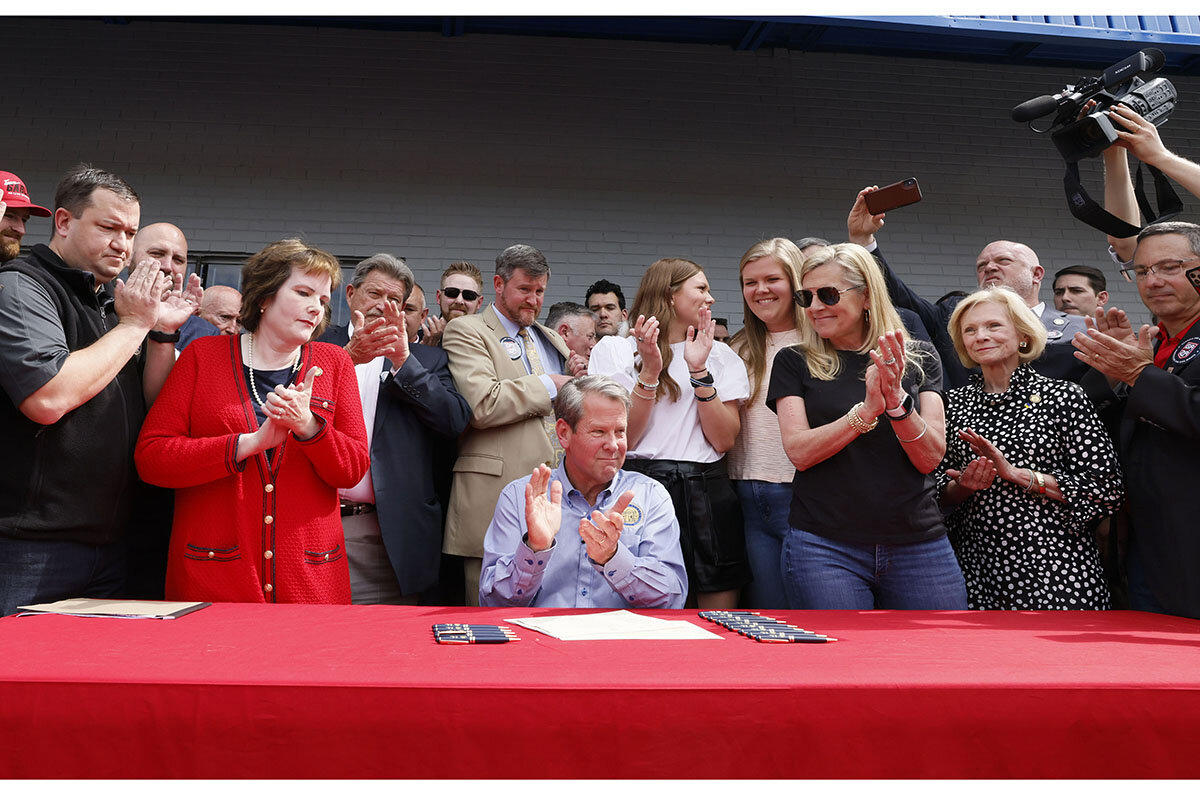
The state legislature passed a major expansion of gun rights back in 2014. Other venues and festivals have adjusted, Mr. Monroe says. Some have banned “illegal weapons” – though it is hard for police to determine which weapons are legal and which are not.
The question of where the line of public safety should be drawn is always shifting. United States law long focused on public safety as a state interest that can be used to justify banning guns or requiring seat belts, for instance. In this summer’s so-called Bruen ruling, the Supreme Court flipped the script, in essence minimizing the idea that the state has an overriding interest in public safety.
Yet the ruling “does recognize that there are certain places that constitutional carry doesn’t apply – schools, courthouses, the state Capitol – and of course that brings up a question: Why?” says Professor Steigerwalt at Georgia State. “We have these tensions and questions of, what ... does it mean to be safe?”
A shifting landscape
The decision to cancel the festival was a product of that uncertain landscape. Local gun rights activist Phil Evans threatened to sue the festival if it did not allow guns. He had already taken one lawsuit to the state supreme court, challenging his removal from Piedmont Park’s Botanical Gardens in 2014 for wearing a weapon.
That legal challenge failed, but the threat was enough to persuade Music Midtown’s organizers to cancel.
It’s no surprise that these questions have come to the fore in Atlanta.
“The state has been a civil rights hotspot since the founding of the republic: for racial equality, in the fight for abortion rights, and now it is the civil rights hotspot for the Second Amendment,” says Timothy Lytton, a constitutional law professor at Georgia State University.
Today, that is overlaid with elements of entertainment culture, as well.
“You have the thriving, musically leading city of Atlanta that has become the cultural capital of the South and the hip-hop center of the United States,” he adds.
The cancellation of Music Midtown sets up “a culture clash between people whose No. 1 issue is firearms rights and people whose No. 1 issue is building a cultural center around music festivals, which have become targets for mass shootings.”
In 2017, the Route 91 Harvest Festival in Las Vegas became the site of the deadliest mass shooting in modern U.S. history. MGM Hotels settled a lawsuit for $800 million in the wake of the massacre. That gave pause to the industry, says Professor Lytton.
What the Supreme Court ruling has done is bring the issue out into the open, says Karen Owen, a political scientist at the University of West Georgia in Carrollton, who studies civic engagement.
“This is a different kind of scenario where we have not – as voters and as community members in society – thought about how the woman or the man next to us could be ... carrying, because it has been concealed,” she says. “Now, where are we? It’s a different land.”

India’s ‘Mother Earth’ cafes provide foraged feasts
In northeast India, “Mother Earth” cafes are helping revive Meghalaya’s Indigenous cuisine. They’re part of a statewide movement aiming to not only safeguard Indigenous knowledge and native plant life, but also boost food security and nutrition in the region.

- Quick Read
- Deep Read ( 5 Min. )
-
By Zinara Rathnayake Contributor
At her old food stall, Dial Muktieh doled out mainland Indian snacks like samosas. But nowadays, she’s gaining popularity for serving up more local fare, like native rice with tham, a condiment made with crabs from nearby rice paddies and prickly ash from the back garden.
Hers is one of several Mei-Ramew cafes – or “Mother Earth” cafes in the local Khasi language – helping break the stigma around Indigenous cuisine in Meghalaya, where demographic shifts and tourism have made communities more reliant on commercially produced food in recent years.
The cafes are part of a broader movement to restore traditional foodways throughout the state by encouraging businesses to utilize ancestral farming and foraging techniques. Advocates have also helped communities establish seed banks to protect the region’s biodiversity.
With a quarter of the world’s undernourished people living in India, experts say localizing foodways can help safeguard communities from economic and environmental disasters.
Senior agriculturist Redian Syiem explains that while city-dwellers found it difficult to access fresh foods during the pandemic, villagers in her area had more options.
“When you can find everything to eat from your backyard, the paddy fields, these water streams, and the forest, there’s no need to buy food at the market,” she says.
India’s ‘Mother Earth’ cafes provide foraged feasts
It’s 2 in the afternoon and Dial Muktieh is rustling up a feast for her customers. River fish cooks in a bamboo hollow as charred skies bring scattered rains outside. A mother digs into a plate of native rice with tham – a condiment prepared with crabs found in the rice paddies, fermented fish, and prickly ash from the back garden – while a farmer rests on a low bench and sips a cup of tea with ja shulia, sticky rice cooked in a bottle gourd and served wrapped in a green leaf.
Welcome to Mei-Ramew Cafe.
Here, in a small village in India’s northeastern state of Meghalaya, Kong Dial – as she’s respectfully known among her customers and community, with kong meaning “sister” in the local Khasi language – serves the native food of the Bhoi people, a subgroup of the Indigenous Khasi people, the state’s largest community.
Kong Dial and her cafe are part of a statewide movement to revive Indigenous foodways throughout Meghalaya. Advocates encourage businesses to use local, seasonal, and wild-grown ingredients, and tap into ancestral farming and foraging techniques. It also involves protecting Meghalaya’s rich biodiversity through seed banks, and families growing near-extinct plants in their backyards.
Safeguarding Indigenous knowledge and native plant life may be reason enough to rethink dinner, but experts also say localizing foodways can boost food security and nutrition. While people in cities found it difficult to access fresh foods during the pandemic, villagers in Khweng faced fewer issues, as they could rely in part on their environment, explains senior agriculturist Redian Syiem.
“Tell me, what do you want to become? Do you want to be rich? Have so much money but no access to food when there’s a crisis like COVID-19?” Kong Redian asks. “Or do you want to have enough food to sustain yourself?”
To her, preserving native biodiversity is a matter of self-sufficiency.
“When you can find everything to eat from your backyard, the paddy fields, these water streams, and the forest, there’s no need to buy food at the market,” Kong Redian says, sitting beside a tray of cultivated and wild-grown greens inside Kong Dial’s cafe.
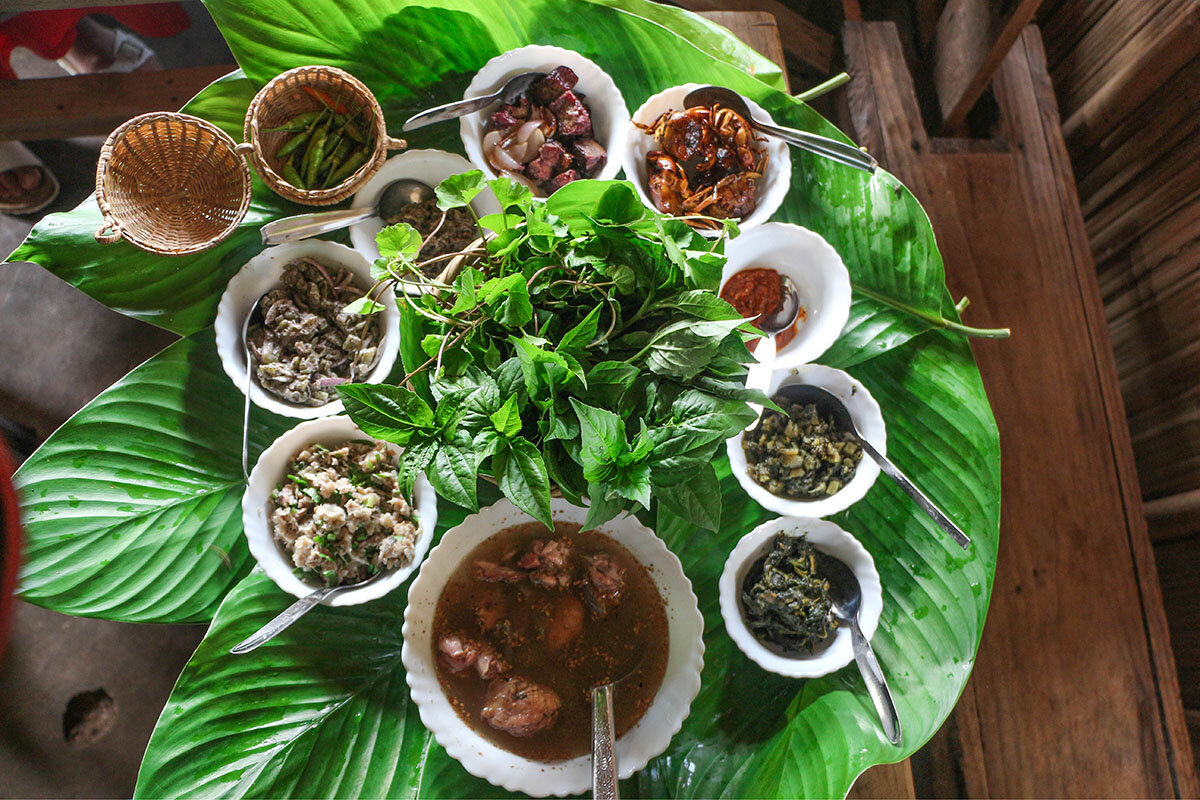
Losing local taste
An influx of business and tourism from other states has pushed Meghalaya restaurants to cater to mainland Indian palates, and over time, experts say those influences have crept into local homes as well. When people cooked white rice, dal, and market-bought vegetables, they forgot the native ingredients that once defined Meghalaya cuisine.
“Meghalaya is home to several Indigenous groups, but we now cook food like those from the metro cities in India,” says Rundolf Mawlieh, content consultant at the North East Slow Food and Agrobiodiversity Society (NESFAS), a nonprofit promoting environmentally friendly local food traditions and agricultural biodiversity.
“For example, we made palak paneer yesterday,” says Mr. Mawlieh, chuckling. “We also grew up watching MTV, so there’s a huge influence of Western culture. If we go to a restaurant, we would order a burger.”
This dependency on commercially produced foods not only has a high carbon footprint, but also makes communities vulnerable to hunger and malnutrition. The World Food Program has declared 2022 the “year of unprecedented hunger,” as a combination of COVID-19, climate change, and rising food costs has pushed “828 million people to go to bed hungry every day.”
A quarter of the world’s undernourished people live in India, where rural food prices have doubled this past year.
Turning to traditional foodways can improve diets and help protect communities from economic and environmental disasters.
“Traditional and diversified food systems are more resilient to changing climate compared to vulnerable monoculture farming we use today,” says transdisciplinary food system researcher Lukas Pawera, whose 2021 research found that only about a third of tribal women in Meghalaya consumed a diverse diet despite the region’s rich food resources.
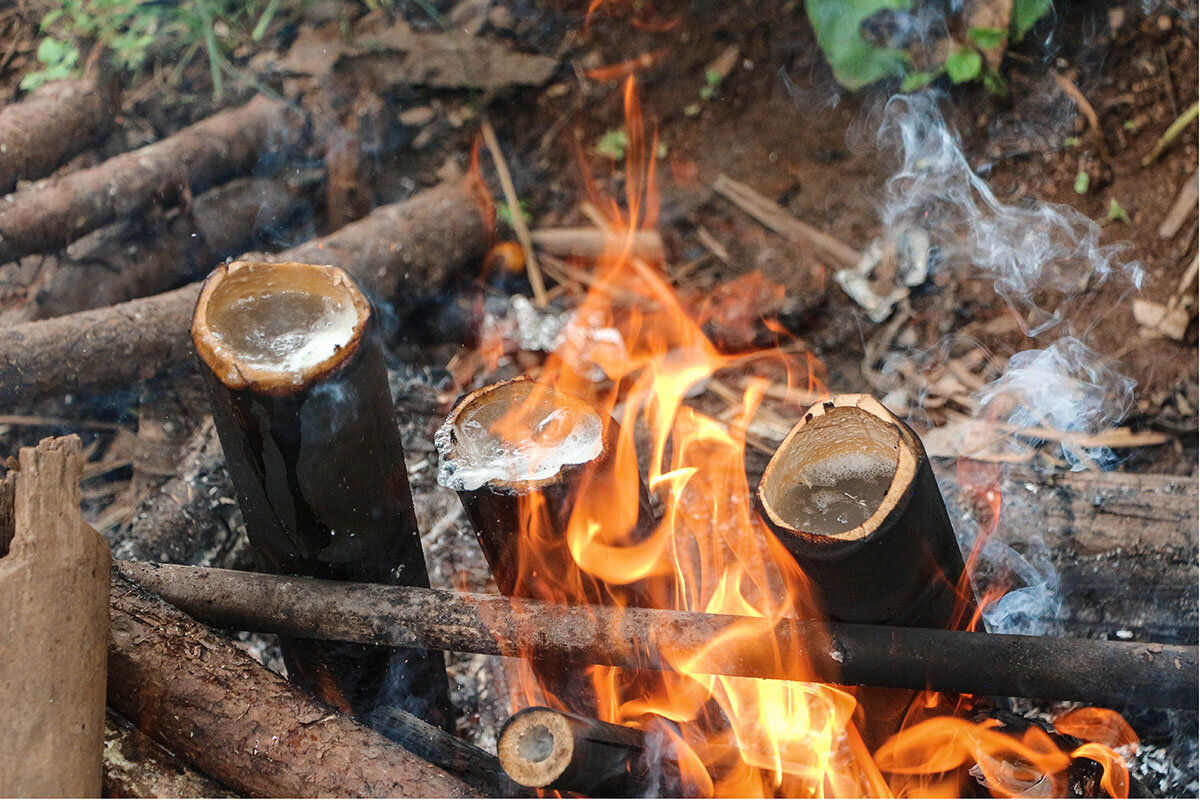
Mother Earth
In Khweng alone, NESFAS has documented 319 edible plant varieties, but researchers rarely saw people eating them. “There was a strong notion that wild greens were poor man’s food,” says Janak Preet Singh, senior associate of livelihood initiatives at NESFAS.
So NESFAS came up with the idea of Mei-Ramew (or “Mother Earth”) cafes, which would help preserve “age-old foraging knowledge” and “encourage entrepreneurship” while breaking stigmas around local food, Mr. Singh says.
When they pitched it to local food vendors nearly 10 years ago, Plantina Kharmujai was the only person who agreed to rework her menu with the Indigenous recipes she learned from her grandmother.
Kong Plantina established the state’s first Mei-Ramew cafe in 2013 with the guidance of NESFAS. Since then, she’s trained other cooks including Kong Dial, who opened her cafe opposite Kong Plantina’s in 2019.
There are now three Mei-Ramew cafes in Meghalaya supported by NESFAS, and several other independent eateries promoting native cuisines scattered across the state.
No longer “poor man’s food”
Mei-Ramew cafe owners say word-of-mouth and recent media exposure has helped their popularity grow. For some customers, this is their first time trying Indigenous cuisine, but for others, it’s the taste of home.

Sagar W. Pakyntein describes it as “the food of my grandparents.” Whenever he’s free, the police subinspector drives over 10 miles to visit the Mei-Ramew cafes in Khweng.
“When I want to eat out, I don’t go to a pizza joint in the city,” Mr. Pakyntein says, digging into khaw lakang, local rice cooked in a bamboo tube with kharang, smoked fish. “I come here with my 3-year-old son. It’s important we teach our younger generations about our own food so that we can preserve this knowledge.”
At her previous stall, Kong Dial prepared mainland Indian snacks like samosa, but she’s garnered more attention for her traditional dishes at the Mei-Ramew Cafe. Customers “loved my Bhoi food and encouraged me to do more,” Kong Dial says.
“This shows the mindset change. She’s changing the image people have about eating local, foraged food,” says Mr. Mawlieh, from NESFAS.
There’s also room for innovation. Kong Plantina is using her ancestral knowledge to come up with new, fun recipes like ruby-pink popsicles made with the extract of roselle flowers she grows in the backyard.
But the movement goes beyond the Mei-Ramew cafes.
NESFAS also conducts farmers markets where people can buy local produce and support cultivators. Seed banks have been set up to ensure native plants survive and thrive, and local entrepreneurs like Gerald Duia, founder of Duia Trailblazers, conduct eco-tours where tourists can experience how tribal communities eat.
“No matter how modern we are, we all need food to survive, and food comes from the earth,” says Mr. Duia. “It’s important to know what we can eat and what nutritional value they have. We need to keep learning and pass our knowledge on to the next generations.”

Book review
Singer, dancer, pilot, spy: Josephine Baker’s wartime career
Beneath her glamorous stage persona, Josephine Baker hid a stalwart heart and iron nerves as a spy for the Allies in Paris during World War II. In her determination to defeat the Nazis, she also hid fighters for the French Resistance and smuggled documents out of North Africa.

- Quick Read
- Deep Read ( 4 Min. )
-
By Barbara Spindel Contributor
Performer Josephine Baker lived a life of glamour and fame in 1920s Paris, where she rubbed shoulders with Ernest Hemingway and Pablo Picasso. Raised in an impoverished Black family in St. Louis, Baker moved to France when she was 19 and quickly became a sensation in the Paris nightclub scene.
As Adolf Hitler consolidated power in occupied Europe, Baker’s global fame provided the perfect cover for spying against the Nazis, as Damien Lewis explores in his compelling book “Agent Josephine: American Beauty, French Hero, British Spy.”
In fast-paced, cinematic prose, he describes Baker’s recruitment, assignments, and espionage among the Axis powers. Her first mission was to determine whether Italian dictator Benito Mussolini planned to form a pact with Hitler. Later, she was tasked with using her friendship with the wife of Japan’s ambassador to France to confirm that Japan also intended to ally with Germany.
Baker did not publicly reveal much about her wartime activities before her death in 1975. Even so, the facts make for an extraordinary tale. In 2021, she was inducted into the Panthéon, France’s tomb of heroes, the first American and first Black woman to receive the country’s highest honor.
Singer, dancer, pilot, spy: Josephine Baker’s wartime career
Josephine Baker was one of the most famous women of her time, so it might seem incongruous that the glamorous diva was also a valuable spy for the Allies during World War II. In the compelling “Agent Josephine: American Beauty, French Hero, British Spy,” Damien Lewis sheds light on the performer’s remarkable espionage work, demonstrating that Baker’s global fame often provided the perfect cover for her perilous clandestine activities.
Baker, whose grandmother was born into slavery in Arkansas, grew up impoverished in St. Louis. She began her show business career in New York City, but realizing that a Black woman in America could only go so far, she sailed for France in 1925 at the age of 19. She fell in love with the country, and the feeling was mutual. Baker quickly became celebrated in Paris’ cabaret scene for her sensuous singing and dancing. She rubbed shoulders with Ernest Hemingway and Pablo Picasso and was known to walk the city streets with her pet cheetah at the end of a diamond-studded leash.
Lewis, a journalist and World War II historian, focuses “Agent Josephine” on the war years. In fast-paced, cinematic prose, he describes Baker’s recruitment by Jacques Abtey, a French intelligence officer who was at first skeptical that the star could be useful to the cause. After all, she was a woman in a male-dominated milieu, she was famous where secrecy was paramount, and she wasn’t even French. But Baker quickly won him over, convincing Abtey of her love for France and her antipathy toward the Nazis.
In addition to performing, Baker also earned her pilot's license in 1936. As Lewis writes, from 1939-40, she flew her own airplane to deliver humanitarian supplies to desperate refugees flowing into the Low Countries.

Abtey, and Baker’s other handlers, quickly realized that her connections and fame could work in their favor. Baker had toured Italy and befriended several Italian diplomats. Her first assignment, before the fall of France in 1940, involved helping to determine whether Italian dictator Benito Mussolini planned to form a pact with Adolf Hitler. Next, she was tasked with using her close friendship with the wife of Japan’s ambassador to France to confirm that Japan also intended to ally with Germany.
After the Nazis occupied Paris, Baker decamped to her country chateau, Milandes, where she gathered Resistance fighters, cached weapons, and hid a number of Jewish refugees. In October 1940 she left France on the pretense of going on tour. With Abtey assuming the identity of her tour manager, the two smuggled valuable documents and photographs out of the country and into neutral Portugal. As Lewis writes, a performer “of her standing would travel with voluminous luggage, which would be stuffed full of tour costumes, make-up and her musical scores – perfect for concealing secret intelligence.” From there the information was sent to Britain's Secret Intelligence Service in London. Baker would repeatedly make use of this pipeline.
Eventually, however, her outspoken anti-Fascist views aroused suspicion, and she was no longer safe in Vichy France. In early 1941 she and Abtey, along with her large menagerie of animals, fled to Algiers. They continued their intelligence gathering from French North Africa, providing information on the area’s tides, beaches, and enemy defenses in advance of November 1942’s Operation Torch, the successful Allied landing in Morocco and Algeria. Baker was gravely ill for months and her hospital room in Casablanca became a safe place for operatives to meet and trade intelligence under pretense of visiting the ailing star.
After she recovered, Baker maintained a relentless touring schedule entertaining Allied troops. When she performed for Americans, her only stipulation was that Black and white GIs sit together. She was acutely aware of the contradictions inherent in Americans fighting for freedom with a segregated military.
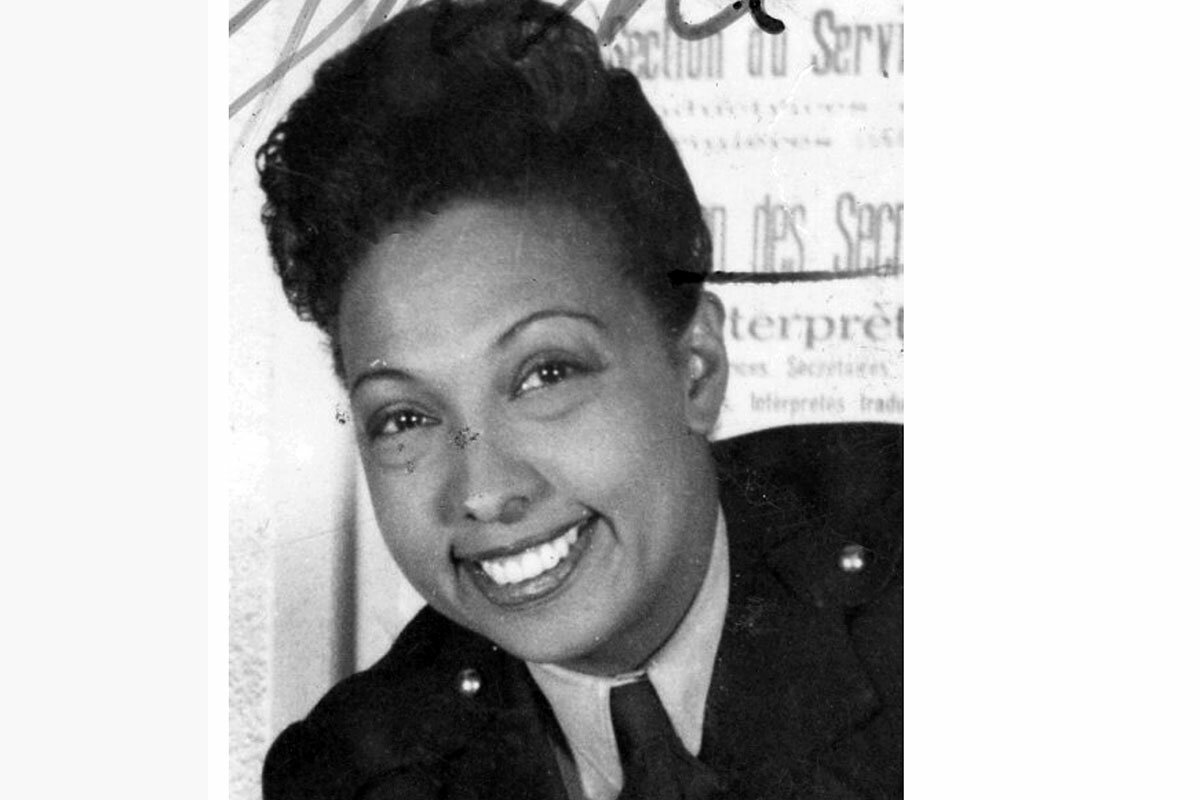
In 1944, she joined the French Air Force as a second lieutenant.
Baker’s courage and commitment are indisputable, but in Lewis’ hands she comes off too saintly, making for a somewhat one-dimensional portrayal. (Previous biographers have sketched a more complex portrait of the star.) In addition, the author’s language can be overwrought.
These shortcomings are perhaps related to the fact that Baker’s own feelings about her wartime service remain inscrutable; she didn’t publicly reveal much about this period before her death in 1975. Even so, the facts alone make for an extraordinary tale. Just last year, Baker was inducted into the Panthéon, France’s tomb of heroes, the first American, first Black woman, and first pilot to receive the country’s highest honor. Clearly her story continues to inspire.

Difference-maker
In Ohio, fine dining serves up training and dignity after prison
What is the best way to help formerly incarcerated people get back on their feet? Inspired by his own experience, a chef in Cleveland offers an instructional approach in which skills and dignity are both key ingredients.

- Quick Read
- Deep Read ( 5 Min. )
What makes Edwins Leadership & Restaurant Institute on Cleveland’s East Side unique isn’t just its French cuisine, but its workers – they’re formerly incarcerated adults.
Over six months, those in training learn skills for employment in the culinary world. More than that, the chef behind it all, Brandon Chrostowski, tries to draw out a sense of self-worth in those who’ve served time by showing them how to attain excellence.
“The single hardest thing we have to do at Edwins is really build esteem in someone that has lost that, or that sense of humanity, through incarceration,” says Mr. Chrostowski.
Over 2,000 people have trained in the program since it started in 2013. Of those, only 600 have graduated because most drop out, often within the first two weeks. (They’re always welcome to reapply.) The restaurant boasts a 95% employment rate for its alumni, and fewer than 1% of graduates are re-incarcerated. Star pupils have gone on to work in restaurants across America and even in France.
“When you come here, it is sincere. You’re welcome. You can feel it,” says Abdul El-Amin, who started his training in June. “I’m seeing so many other opportunities that I didn’t think about when I was incarcerated.”
In Ohio, fine dining serves up training and dignity after prison
Brandon Chrostowski is telling his origin story for probably the thousandth time. He’s pacing the stage of a local high school, holding his microphone with the confidence of a rock star. Mr. Chrostowski is a distinguished chef – he was a restaurateur semifinalist in the 2022 James Beard awards – and founder of a Cleveland restaurant with a philanthropic mission. Yet he’s ambivalent about all the acclaim. He’s tasted what it’s like to be stripped of dignity. At 18 he was arrested for fleeing and eluding the police. He and some friends had been in a car with drugs they intended to sell.
“I learned a lot of things. One, the dehumanization in the criminal justice system,” he tells the students at Gilmour Academy. “Also, the idea of freedom. You don’t really know what freedom is until you lose it.”
A lenient judge decided against sentencing him to prison. Mr. Chrostowski has never forgotten that he was fortunate not to serve a 5-to-10-year sentence. It’s the reason he launched Edwins Leadership & Restaurant Institute on Cleveland’s East Side.
What makes Edwins unique isn’t just its French cuisine, but its workers – they’re formerly incarcerated adults. Over six months, those in training learn skills for employment in the culinary world. More than that, Mr. Chrostowski tries to draw out a sense of self-worth in those who’ve served time by showing them how to attain excellence. “The single hardest thing we have to do at Edwins is really build esteem in someone that has lost that, or that sense of humanity, through incarceration,” says Mr. Chrostowski.
Hours before giving his speech at the high school, Mr. Chrostowski strides into a kitchen where two trainees are singing along to a Bobby Womack tune on the radio. Tying a half apron around his waist, the chef quickly assesses a hunk of braised beef inside a pot as large as a bassinet.
“Got bay leaves?” he asks an apprentice named Richie. “And celery?”
As Mr. Chrostowski shares tips with Richie, he picks up a knife and demonstrates how to slice asparagus. In 2017, Edwins was the subject of an Oscar-nominated short documentary titled “Knife Skills.” Sahithya Wintrich, a former Edwins board member who appears in the film, says the program is designed to instill confidence. “As soon as they are able to learn how to perfectly chop a vegetable or dice an onion – use the julienne technique, you know, all the different slicing, chopping, mixing, cooking techniques – it creates a certain dignity within themselves,” says Ms. Wintrich in an interview. “And also how other people view them. ... Their past doesn’t matter anymore.”
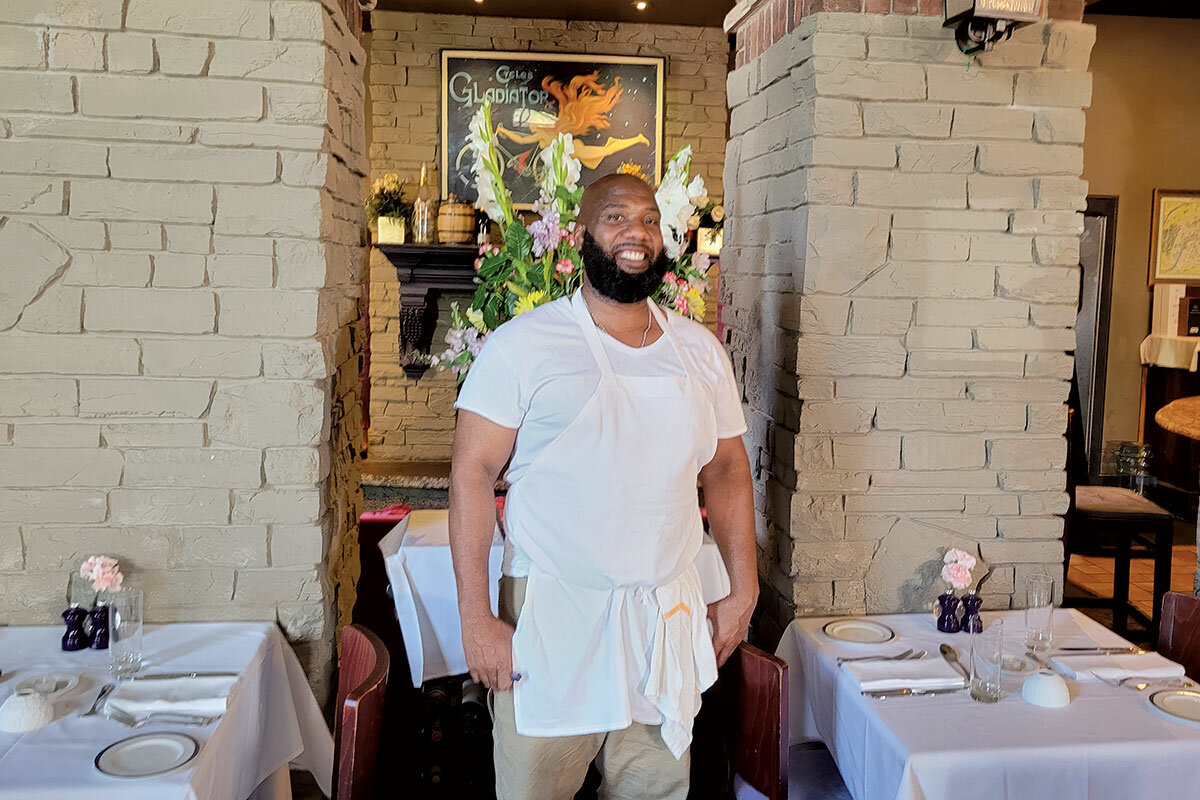
Abdul El-Amin enrolled in the program in June after being incarcerated for 20 years. “When you come here, it is sincere. You’re welcome. You can feel it,” he says after his first two weeks of training. He adds, “I’m seeing so many other opportunities that I didn’t think about when I was incarcerated.”
That’s not to say the program isn’t demanding. Over 2,000 people have trained at Edwins since its opening in 2013. Of those, only 600 have graduated because most drop out, often within the first two weeks. (They’re always welcome to reapply.) The program boasts a 95% employment rate for its alumni, and fewer than 1% of graduates are re-incarcerated. Star pupils have gone on to work in restaurants across America and even in France.
“[Mr. Chrostowski] really doesn’t care what walk of life you’re from, who you are, what you’ve done,” says William Brown, a staff member at Cleveland’s Community Assessment & Treatment Services, a rehabilitation organization that enrolls promising individuals in the Edwins program. “He wants to see you succeed. And he will go the extra mile.”
Mr. Chrostowski has a hectic daily schedule. During peak restaurant rush hours, the chef admits to hurling pans in frustration, but they’re not aimed at anyone. “I still have my moments,” he says. “I’m not perfect.”
He pursues the exacting standards he learned as an apprentice at restaurants such as Charlie Trotter’s in Chicago, Le Cirque in New York, and Lucas Carton in Paris. He rose fast. But he’s never forgotten his first break. In the late 1990s, a Detroit chef named George Kalergis took him in while he was still on parole.
Years later, Mr. Kalergis called from Detroit with bad news. A man named Quentin, who’d learned the rudiments of restaurant cooking alongside Mr. Chrostowski, had been stabbed to death. A week later, Mr. Kalergis called again. Another restaurant worker had been killed.
“I started to think, ‘How is it possible I’m here, and others are not?’” says Mr. Chrostowski. “And so, 2004, 18 years ago, I decided to say, ‘I’m going to build a restaurant that can change the world.’” He wanted to help others, just as Chef Kalergis had helped him. But it took another decade of working in restaurants – including a move to Cleveland in 2008 – before he was able to raise the money to fulfill his vision.
Mr. Chrostowski came up with the name, which is shorthand for “Education wins.” Edwin is also the chef’s middle name. A few years after moving to Cleveland, he opened his restaurant in a historic, racially diverse area called Shaker Square. In 2020, he expanded by opening a second restaurant, Edwins Too, on the opposite side of the town’s leafy square. He’s also launched a French bakery and a butchery. The expansions have helped the area become a dining destination.
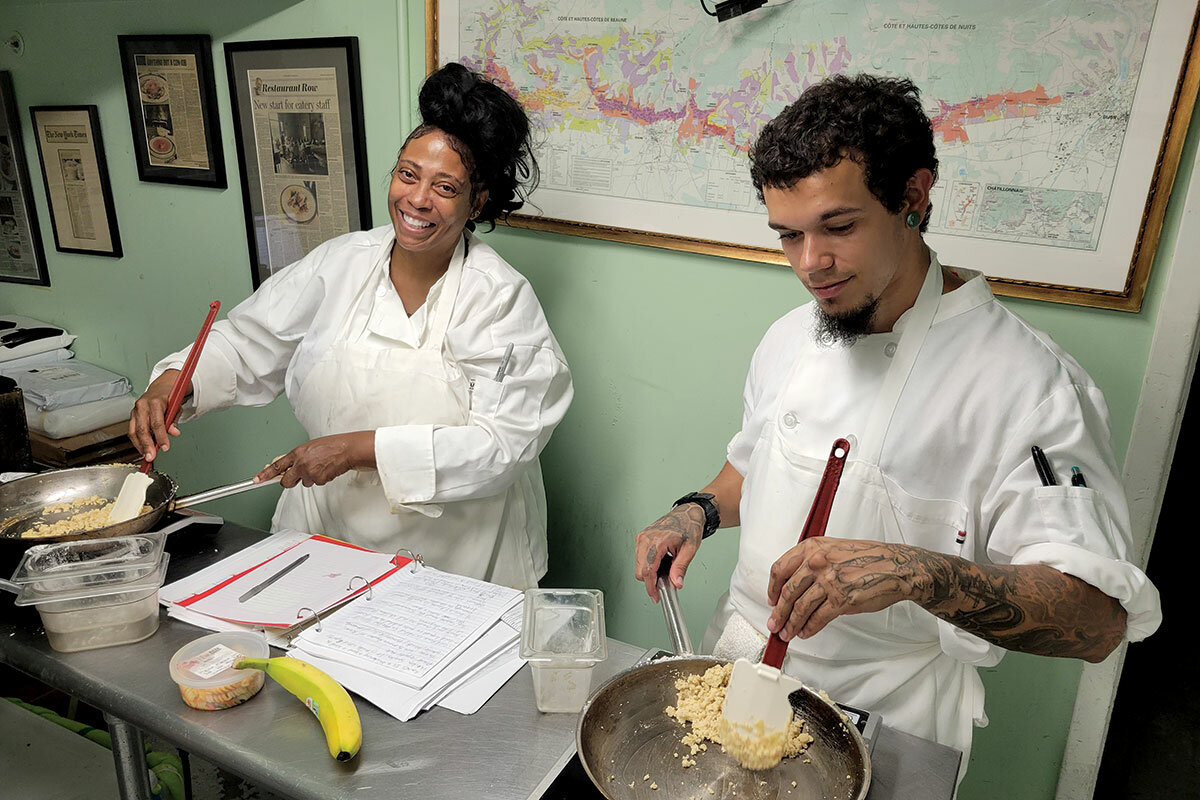
Just off the main street in Shaker Square, Mr. Chrostowski proudly shows off his latest project, which will become a child care center. “We’ve raised about $250,000 for a family center or day care,” he says. “Free day care for staff and students, because 80% of our students with children don’t finish. It’s a big number and we want to change that.”
The chef also wants to help outside Ohio. In April he traveled to his ancestral home of Poland to cook for refugees fleeing Ukraine. He’s also created a 30-hour curriculum and distributed it on 400,000 tablets to prisons in the United States. Dee and Jimmy Haslam, co-owners of the Cleveland Browns football team, will pay for transportation for anyone in the U.S. who completes the virtual instruction and applies to join the Edwins program.
“[Brandon] has a big heart,” says trainee Ce’Lo Croff, whose ambition is to own a food truck. “Just watching Brandon and the amazing things that he does, it is just so true that anything you set your mind to literally is possible. And you have to have the diligence and the perseverance and the drive to just go get it.”
Other headline stories we’re watching
(Get live updates throughout the day.)The Monitor's View
Undoing fear of hate among minorities
- Quick Read
- Deep Read ( 2 Min. )
-
By the Monitor's Editorial Board
A series of killings of Muslim men in Albuquerque, New Mexico, has sharpened the fears of Muslims across the United States. They are not alone. About 1 in 3 Black adults and 1 in 7 Hispanic adults worry daily that “they might be threatened or attacked due to their race or ethnicity,” according to a May survey by Pew. Those concerns have prompted some minorities to change their daily routines to reduce their vulnerability.
At different times in American history, minorities have felt motivated by hate or fear to seek political or social change. That motivation has been particularly pronounced for Asian Americans during the pandemic. Violence against Asian Americans spiked as the origin of COVID-19 in China was politicized. That aggression, however, has led to a range of alternative responses. In Oakland, California, for example, Asian Americans formed an unarmed neighborhood watch patrol and reduced incidents of hate by strengthening their practice of community.
In Albuquerque, meanwhile, one prominent Islamic leader offered this advice on how the city’s Muslims could respond to the killings. “We should never let evil dictate our life,” Mahmoud Eldenawi, imam of the Islamic Center of New Mexico, told The Guardian newspaper.
Undoing fear of hate among minorities

A series of killings of Muslim men in Albuquerque, New Mexico, has sharpened the fears of Muslims across the United States. Already last year, Muslims reported a 28% rise in incidents of hate and bias, according to the Council on American-Islamic Relations.
They are not alone. About 1 in 3 Black adults and 1 in 7 Hispanic adults worry daily that “they might be threatened or attacked due to their race or ethnicity,” according to a May survey by Pew. Those concerns have prompted some minorities to change their daily routines to reduce their vulnerability.
At different times in American history, minorities have felt motivated by hate or fear to seek political or social change. That motivation has been particularly pronounced for Asian Americans during the pandemic. Violence against Asian Americans spiked as the origin of COVID-19 in China was politicized. That aggression, however, has led to a range of alternative responses.
In Oakland, California, for example, Asian Americans formed an unarmed neighborhood watch patrol and reduced incidents of hate by strengthening their practice of community. In June, thousands of Asian Americans and Pacific Islanders held a weekend “unity” rally in Washington, D.C., to counter stigmas against them.
In addition, Asian American educators have written new public school curricula on history and culture that have already been adopted or are being considered in a growing number of states. The only way to reverse hate against Asian Americans is “by teaching people who we are, what our history has been, and what our experience has led us to,” said New York state Sen. John Liu in support of a bill expanding Asian American history education.
These corrective initiatives, wrote Russell Jeung, a professor of Asian American studies at San Francisco State University, in a recent essay for The Christian Century, share a recognition that “we can’t address racism by vilifying individual racist perpetrators.” Addressing hatred, he argued, requires humility. “Instead of reacting with a fight-flight response of our own, which just perpetuates the cycle, we can try to see our enemy with empathy – since we all hold implicit bias.”
In Albuquerque, meanwhile, where police announced Tuesday that they have a suspect in custody, one prominent Islamic leader offered this advice on how the city’s Muslims could respond to the killings. “We should never let evil dictate our life,” Mahmoud Eldenawi, imam of the Islamic Center of New Mexico, told The Guardian newspaper. His courage reflects a lesson many Asian Americans have already embraced: that hate and fear cannot flourish in the face of meekness and affection.

A Christian Science Perspective
Each weekday, the Monitor includes one clearly labeled religious article offering spiritual insight on contemporary issues, including the news. The publication – in its various forms – is produced for anyone who cares about the progress of the human endeavor around the world and seeks news reported with compassion, intelligence, and an essentially constructive lens. For many, that caring has religious roots. For many, it does not. The Monitor has always embraced both audiences. The Monitor is owned by a church – The First Church of Christ, Scientist, in Boston – whose founder was concerned with both the state of the world and the quality of available news.
A spiritual approach to preventing gun violence
- Quick Read
- Read or Listen ( 4 Min. )
-
By Beth Schaefer
Letting the light of God, divine Love, illumine how we see and interact with others is a powerful force for good, as a woman experienced while working at an organization that provided temporary housing for teens in crisis.
A spiritual approach to preventing gun violence
I live a couple of hours from Uvalde, Texas, and the impact of the tragedy at Robb Elementary School continues to reverberate throughout the community. Clearly we aren’t the only region trying to come to terms with, and prevent, similar tragic outcomes. Whether in regard to other mass shootings or increased gun violence within cities, many individuals and communities are hoping and working for change.
Living our lives in accord with spiritual precepts that prompt us to love our neighbor as ourself requires us to care enough to recognize when things aren’t right with those in our community and do what we can to help. And as we look for answers, let’s make sure to leave room for a spiritual approach.
Turning our attention to the Divine quiets the fray of fear and anger that would keep us from discerning ideas from God, the infinite divine Mind, who is always imparting ideas that bring harmony. And doing so aids us in getting to the heart of the matter – addressing the dark thoughts and emotions that are so often behind violent acts.
Addressing the need to overcome such darkened thinking, Mary Baker Eddy, the founder of Christian Science, wrote: “The pent-up elements of mortal mind need no terrible detonation to free them. Envy, rivalry, hate need no temporary indulgence that they be destroyed through suffering; they should be stifled from lack of air and freedom” (“Miscellaneous Writings 1883-1896,” p. 356).
The best way I have found to stifle those “pent-up elements” of mortal thinking that can lead to violence is to recognize everyone’s true, God-created identity. Our spiritual identity is incapable of being drawn to or touched by evil. The New King James Bible tells us, “I know the thoughts that I think toward you, says the Lord, thoughts of peace and not of evil, to give you a future and a hope” (Jeremiah 29:11). No one is made to harm. Each of us is made to love. Understanding this is a powerful tool toward disarmament.
The Old Testament describes a situation where David felt disrespected by a man named Nabal, and as a result, David decided to kill Nabal. Abigail, Nabal’s wife, courageously intervened and appealed to David’s innate goodness. The spiritual astuteness, wisdom, courage, and love she expressed neutralized the explosive anger David was feeling, causing him to realize the error of his ways and averting the crisis (see I Samuel 25:4-38).
Unlike Abigail, we may not be able to directly reason with or even know of those intent on perpetrating an attack. But prayer connects us to God, who is ever-present, intelligent good, and whose light is reflected by each of us. The Bible tells us, “God is light, and in him is no darkness at all” (I John 1:5). Nothing can hide from the light of God, divine Love.
Christ Jesus proved this Love to be the greatest power there is. Through Love, he faced down murderous hatred and healed mental and physical illness. He also showed that when paralyzing fear threatens, the Christ, God’s saving power, is present to guide and protect us. Jesus didn’t excuse evil. He exposed it and called it a “liar” – whose lies can be corrected through Love. He showed that divine Love gives us guardrails as well as builds bridges.
Several years ago, I worked for an organization that provided temporary housing for teens in crisis. During that time, youths with more hardened backgrounds were sent our way, which caused challenges within the program.
I prayed each day before I went to work to recognize God as being in control. I also prayed to see beyond the label of troubled mortal to the true identity of each one as a child of God – spiritual and good, created to love and be loved.
At one point, a large chef’s knife was missing from the kitchen. Several days later, the knife was found hidden in the boys’ dormitory, and better security practices were put into place.
Some time later, a young man greeted me and introduced himself as having been through my program during the time of the knife incident. He said that he and another boy had become so angry at being detained that they’d planned to attack me with the knife, take my car, and get away. But at the last minute, they had decided not to. He wanted me to know how much his life had changed for the better since then, and I rejoiced with him.
The vast majority of people want a society where all violence becomes a thing of the past. To get there, we can start in our own thinking to deactivate anger, hatred, and resentment through Love. We can look for and cherish the God-created identity of each individual in our communities. And we can learn to love those who most need our love, even if we don’t know them. In our collective efforts to turn the corner on stopping gun violence, let’s let spiritual steps enlighten our way!
New King James Version®. Copyright © 1982 by Thomas Nelson. Used by permission. All rights reserved.

A message of love
A tennis icon holds court for the last time

A look ahead
Thanks for joining us. Come back tomorrow when our Scott Peterson reports on whether the progress made in the Iran nuclear talks is enough to overcome deep distrust and save the deal.



